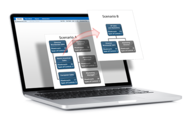There has been a league of digital ink spilled over holacracy since Zappos adopted the practice in 2013, but to summarise, holacracy is a management style that replaces a traditional, hierarchical organisational structure with role based ‘circles’ based on key functional areas, projects or tasks.
What is it and where did it come from?
Many think the organisational structure of holacracy is flat. There would be no reason to drastically change org charts if that were true. It is only power distribution that is flat, not the structure itself.
The breakdown of teams and departments is complex in this management style. Employees occupy multiple teams, and restructures are done monthly. There are no departments, let alone managers of departments.
So where did this radical idea come from?
Holacracy was first used by Ternary Software. Founder, Brian Robertson, is also considered the founder of the management style. It has existed in some form since 2003, but has only gained international headlines in 2013 when Zappos became the largest company to adopt the radical approach to people management.
Today, over 300 organisations are using holacracy. All it takes is one quirky CEO to completely redefine an entire suite of HR tech and theory.
Here is what you need to know, and the impact it stands to make on organisational development:
Employees are given more freedom to act as entrepreneurs in their roles, employees work together in circles to complete larger projects, and circles work together to create value for the organisation.
Holacracy circles are like individual cells
A common analogy for holacracy is cells in an organism. A cell operates independently, but also works with others to create an organ, and then the organs work together to make an organism.
Circles represent complex systems in holacracy. Employees are given more freedom to act as entrepreneurs in their roles, employees work together in circles to complete larger projects, and circles work together to create value for the organisation.
Employees can be in multiple circles working on multiple projects. These circles change as new skills are needed in projects. The restructuring of circles is the equivalent of org restructures in a traditional organisation.
The difference is that these circle restructures are made monthly, rather than every couple of years.
How to visualise circles using org charts
Your org chart would have to display employees in a honeycomb network, as a series of circles. Org charts would need to show the circles employees belong to, along with the possibility of circles within circles.
The easiest way to do this in an org charting tool is to setup multiple views for different types of circles. For example, you may have a projects view showing the circles for projects alone, then another view for general functional areas, and perhaps one for skill based charts.
Holacracy would actually make org charts more complex and nuanced, rather than simply flattening out the structure.
Succession planning in holacracy
Holacracy has been used in Zappos for two years. One of the biggest challenges CEO Tony Hsieh is facing is how to pay people as they grow in the organisation.
Remuneration can’t be based on hierarchy in holacracy, because there is none. Employees can’t be paid based on how high up the org chart they are.
Zappos is considering a badge based remuneration system, similar to what Ternary Software uses for their employees. Badges are awarded to peers based on displayed skills. An employee’s pay increases as they collect sets of badges.
Employees can earn badges in any discipline. The logic is that pay is based on skill, rather than placement in an organisation. Employees can earn any badge, and even the value of badges is open for discussion.
Employees earn badges in areas that interest them, allowing employees to specialise their skill set. Horizontal shifts become easier without restricting employee roles.
This concept means employees can grow the way that suits them. Badges are awarded by peers, making skill the key determinant of compensation.
But badges are just one option for succession planning. Brian Robertson has said there are multiple modules for succession planning in holacracy, and at this stage it’s hard to pick a clear favourite.
How to track badges in org charts
Perhaps org charts will have to include a section for badges collected by employees, making everyone look like Pokemon Trainers or Olympic Athletes.
Within a org charting tool like org.manager, any data included in your HRIS can be visualised in your org charts, so you would need to find a way to track which badges have been awarded to each employee.
Holacracy might sound daunting to you. Fortunately, most organisations just need better organisational planning to be more effective.
Job descriptions in holacracy
Holacracy gets rid of traditional job descriptions, the argument being that many job descriptions do not reflect the actual roles and responsibilities of an employee, especially years down the line.
Holacracy attempts to fix this problem by making job descriptions fluid. Employees decide what roles they need to fill and update them over time.
Roles are based on an employee’s skills and what circles they operate in. An employee could have several roles in multiple circles in an organisation.
New hires would be defined by a series of related capability gaps. The use of roles means the responsibilities of a new hire can still be articulated.
How to visualise these roles in your org chart
Your org charts would need to display an employee’s skills, the circles they are in, and the roles they fill in those circles – almost as a sort of employee directory.
All of these details would be updated on a monthly basis, and are defined by employees themselves. In a tool like org.manager, it’s easy to give everyone the visibility to view their charts, but it would be up to HR to make sure that your HRIS is kept up to date to ensure your charts accurately display who is a part of each circle.
How accountability works in holacracy
Employees volunteer to fill roles in holacracy. This does not mean unpopular roles are left by the wayside. Employees will be given charge of a domain, be it a website, sales, or a section of source code. Employees then become responsible for everything related to their domain, and others must ask permission before working with it.
Accountability for a role then extends to the circle an employee works in, rather than just one manager. Employees in a circle make each other accountable to their roles for the sake of the project. Underperformance becomes more visible as employees depend on each other to complete their roles.
How to show accountability in your org charts
Accountability is dispersed in holacracy. Org charts would show employees must answer to their circles, rather than their managers, meaning it could be worthwhile having your Reports To fields based on a circle rather than an individual person or position.
The final word: Does it work?
Tony Hsieh and Brian Robertson are constantly asked about holacracy’s effectiveness. Both admit it is too early to tell.
Many factors go into the effectiveness of an organisation, and Robertson admits the adoption of holacracy is not a sole catalyst for business success. Both Hsieh and Robertson say employees can only go with their gut feeling on holacracy at the moment. Conclusive data on the effectiveness of holacracy is still being developed.
Many employees at Zappos are enjoying the new management structure. They feel that holacracy has made their jobs easier, removing unnecessary red tape and giving every employee an equal voice.
Whilst it may be too early to state the effectiveness of Holacracy yet, it is refreshing to see organisations such as Zappos who are willing to take risks to try something new in the management space.
Time is yet to tell whether holacracy is the future of management, but if it does gain more popularity, we are going to have to rethink the way we use org charts.
Of course, if you’d just like more visibility on your organisational structure, you may only need a better management tool rather than a whole new system of management. Check out org.manager and what it can do to help chart your organisation.



